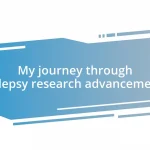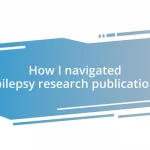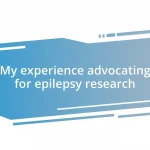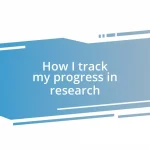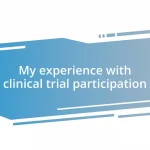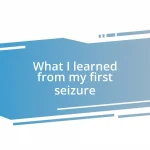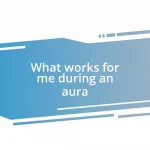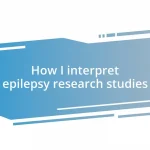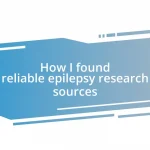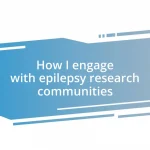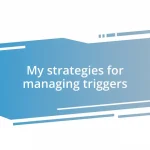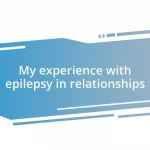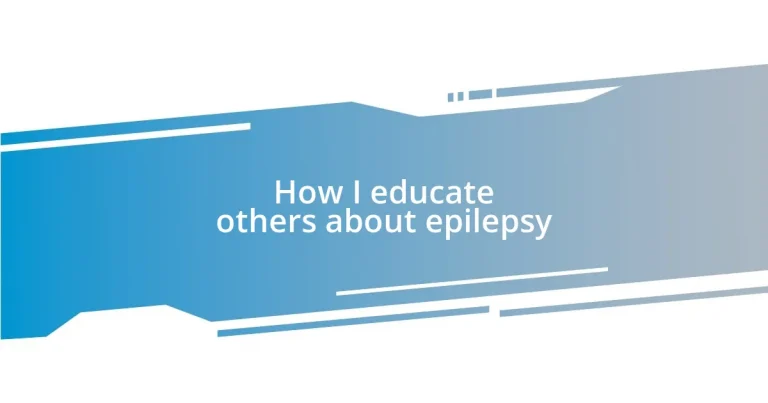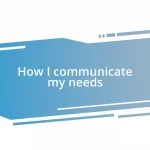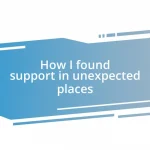Key takeaways:
- Epilepsy affects 1 in 26 people and has significant emotional and societal impacts, often leading to anxiety, isolation, and discrimination.
- Common misconceptions include the belief that individuals with epilepsy cannot lead active lives, that all seizures are the same, and the myth that one can swallow their tongue during a seizure.
- Effective educational materials should use clear language, engaging visuals, diverse formats, practical examples, and resource access to connect with audiences.
- Personal storytelling and collaboration with healthcare professionals enhance understanding and foster empathy regarding epilepsy in the community.
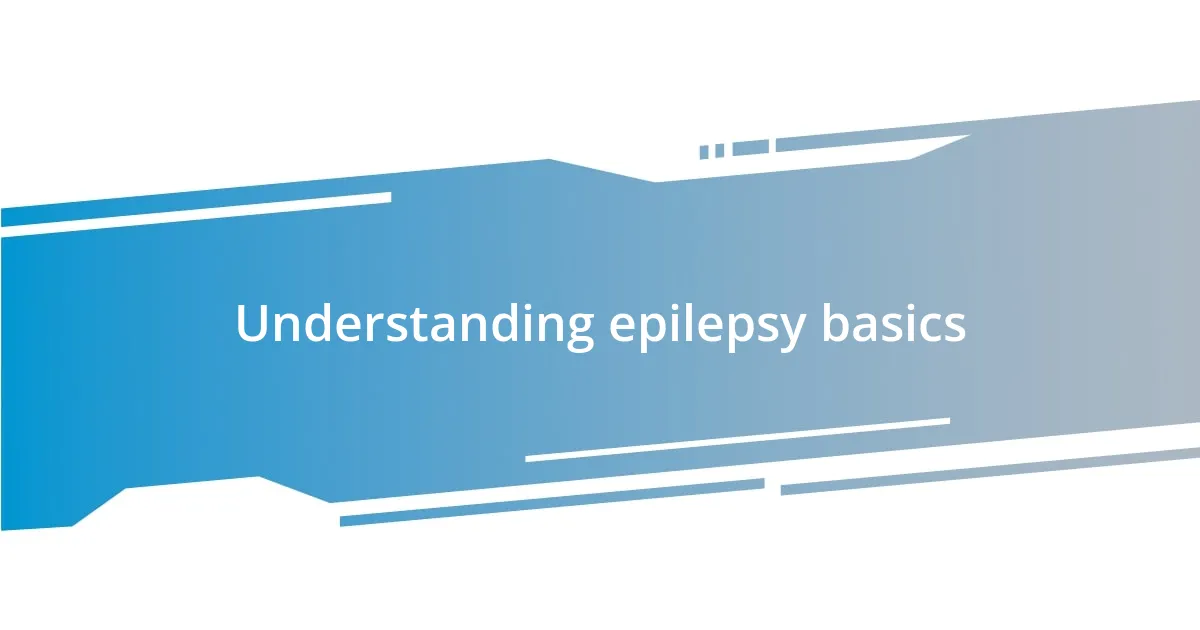
Understanding epilepsy and its impact
Epilepsy is often misunderstood. When I first learned about it through a friend, I realized how vital it is to educate ourselves on the specifics of this condition. Did you know that epilepsy affects about 1 in 26 people in their lifetime? This statistic shocked me. It highlights just how common it is, yet it remains shrouded in stigma and misconception.
The impact of epilepsy extends far beyond the occasional seizure. I once witnessed my friend’s struggle with anxiety and isolation because of the unpredictability of their seizures. It made me reflect on how many individuals may feel disconnected from their peers or family. How many opportunities do we miss to understand them better? This emotional resonance drives home the fact that these experiences can profoundly shape their day-to-day lives.
Moreover, the societal impact cannot be ignored. Imagine the challenges someone faces in the workplace, grappling with not just their health, but also worries about discrimination. I’ve met people who felt forced to hide their condition, fearing it would define how others perceive them. Isn’t it time we change the narrative? Understanding epilepsy means fostering an environment of empathy and support for everyone affected.
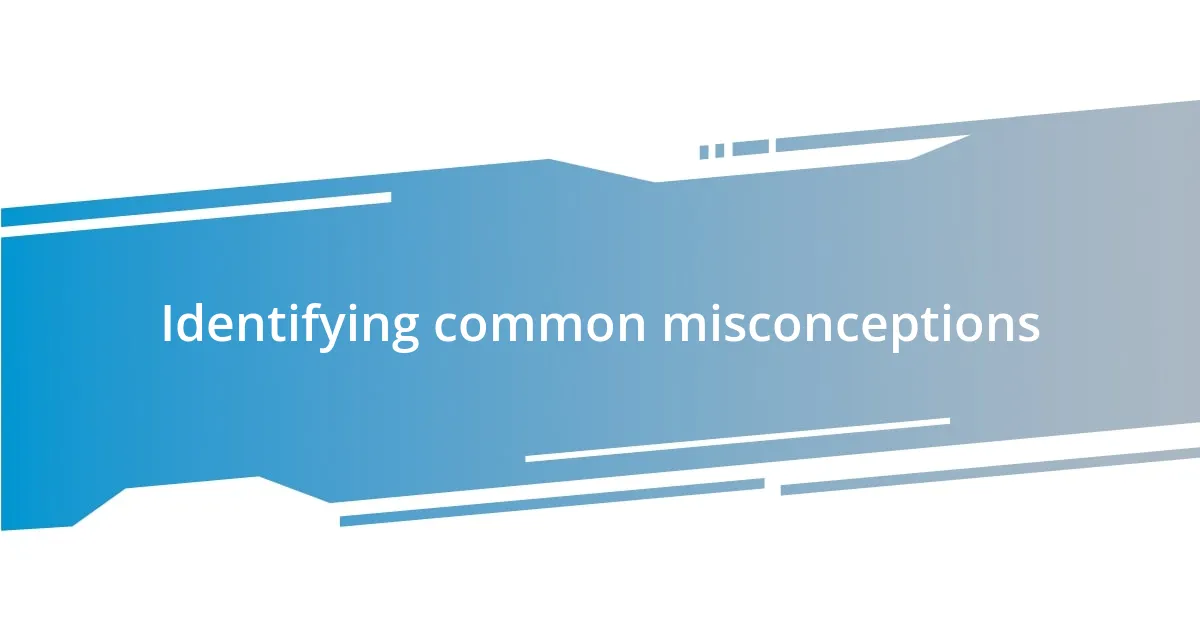
Identifying common misconceptions about epilepsy
It’s surprising how many misconceptions about epilepsy still circulate today. One of the most common is the belief that people with epilepsy cannot lead active, fulfilling lives. I remember meeting a remarkable woman who, despite having epilepsy, climbed mountains and ran marathons. Her story reshaped my understanding of the condition. It taught me that with proper management and support, individuals with epilepsy can pursue passions just like anyone else.
Another misconception is that all seizures are the same. This is simply not true. When I first learned about the various types of seizures, I was shocked to realize how diverse they can be. For example, my friend’s seizures were brief and often unnoticeable, happening as staring spells. Many people might overlook these subtle signs. It’s essential, therefore, for us to recognize that epilepsy is not a one-size-fits-all condition. Education plays a key role in breaking down these false beliefs.
Frequently, I hear the assumption that someone having a seizure is in danger of swallowing their tongue. I used to hold this belief myself until a neurologist explained to me the actual risks involved. It’s crucial to remember that the best response is to provide a safe space for the person having the seizure, rather than panic. This understanding can help eliminate fear and promote a more supportive environment for those affected by epilepsy.
| Misconception | Fact |
|---|---|
| People with epilepsy cannot lead active lives | Many individuals manage their condition successfully and pursue various activities, including sports and adventure. |
| All seizures are the same | There are multiple types of seizures, each with unique characteristics and implications. |
| Someone having a seizure can swallow their tongue | You cannot swallow your tongue during a seizure; the priority is to keep the person safe. |
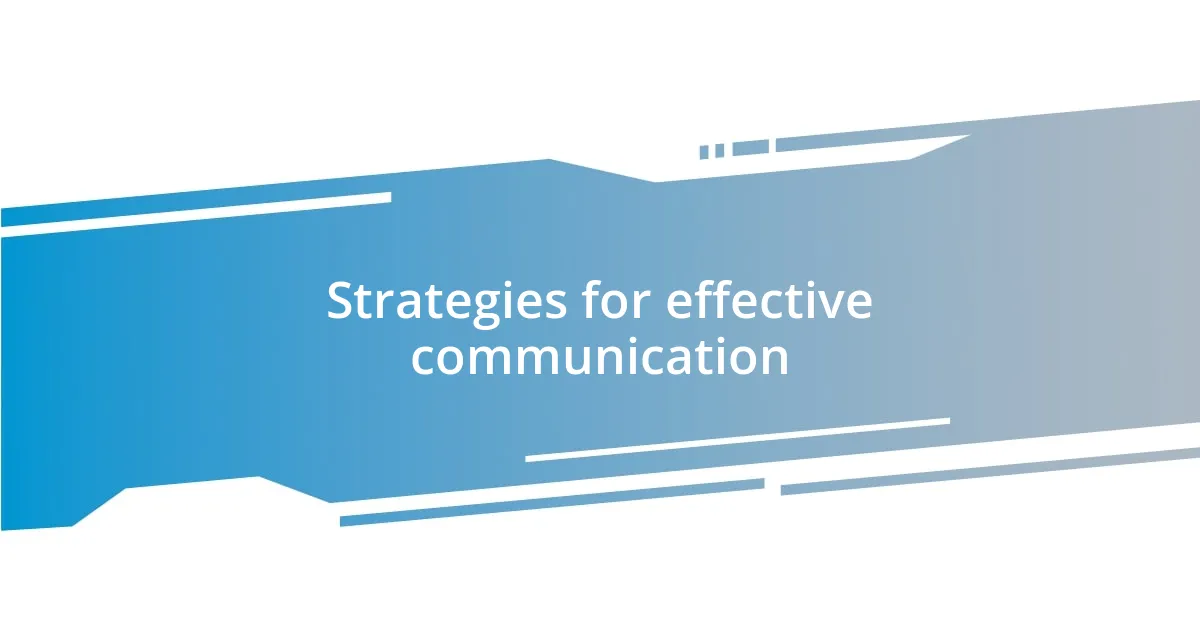
Developing effective educational materials
Creating effective educational materials on epilepsy requires a thoughtful approach. I remember when I developed a brochure for a local awareness campaign. It was rewarding to explain complex information in a clear, easily digestible way. Each section of that brochure contained a balance of factual data and personal stories. This combination helped draw readers in and made the information feel more relatable.
Here are a few key components that I believe make educational materials impactful:
- Clear Language: Use simple and accessible vocabulary to ensure everyone understands.
- Engaging Visuals: Include images and graphics that resonate emotionally while enhancing comprehension.
- Diverse Formats: Consider using videos, podcasts, or interactive webinars for varied learning preferences.
- Practical Examples: Share real-life scenarios that highlight the daily experiences of those with epilepsy.
- Resource Access: Provide links to support services, hotlines, or further reading to empower readers with additional help.
By focusing on these elements, I’ve found that audiences are more likely to connect with the material and retain the information presented.
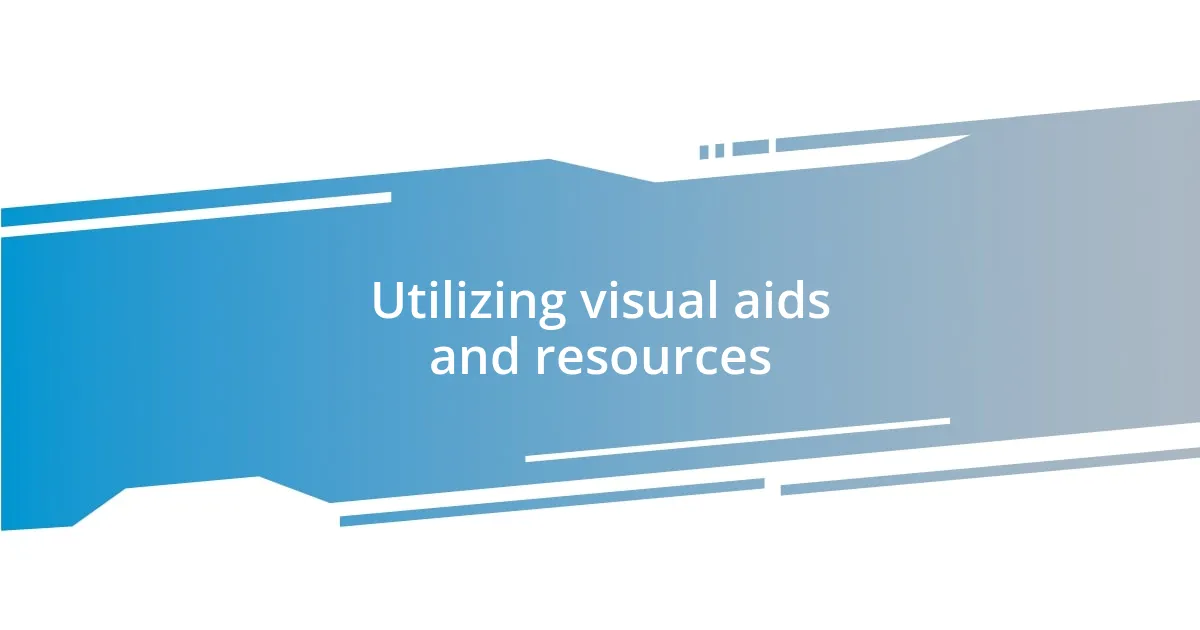
Utilizing social media for awareness
Social media is a powerful tool for raising awareness about epilepsy, and I’ve seen its impact firsthand. I remember posting an infographic about seizure types on my page, and the response was overwhelming. People began to share their own stories and experiences, creating a ripple effect that sparked conversations I never anticipated. It made me realize how vital it is to put accurate and relatable information in front of others. Have you thought about how sharing your own journey could inspire someone else?
One of my favorite moments on social media came when I hosted a live Q&A session about epilepsy. I was nervous at first, but watching the questions pour in made me feel connected to a larger community. It was enlightening to engage with individuals who shared their confusion about the condition. Their curiosity pushed me to dig deeper and present information in a way that resonated with them. This experience reassured me that even a single post can create a safe space for learning and sharing.
I often remind myself that awareness is not just about sharing facts; it’s about fostering empathy. I’ve seen campaigns that use personal narratives alongside statistics, and this blend can be incredibly effective. For instance, when I shared a video of a friend discussing her experience with epilepsy, I was amazed at how many people reached out to express their support. It reminded me that these platforms can break down barriers and unite us in our experiences. Have you ever used social media to tell a story that resonated with others? That connection makes the mission worthwhile.
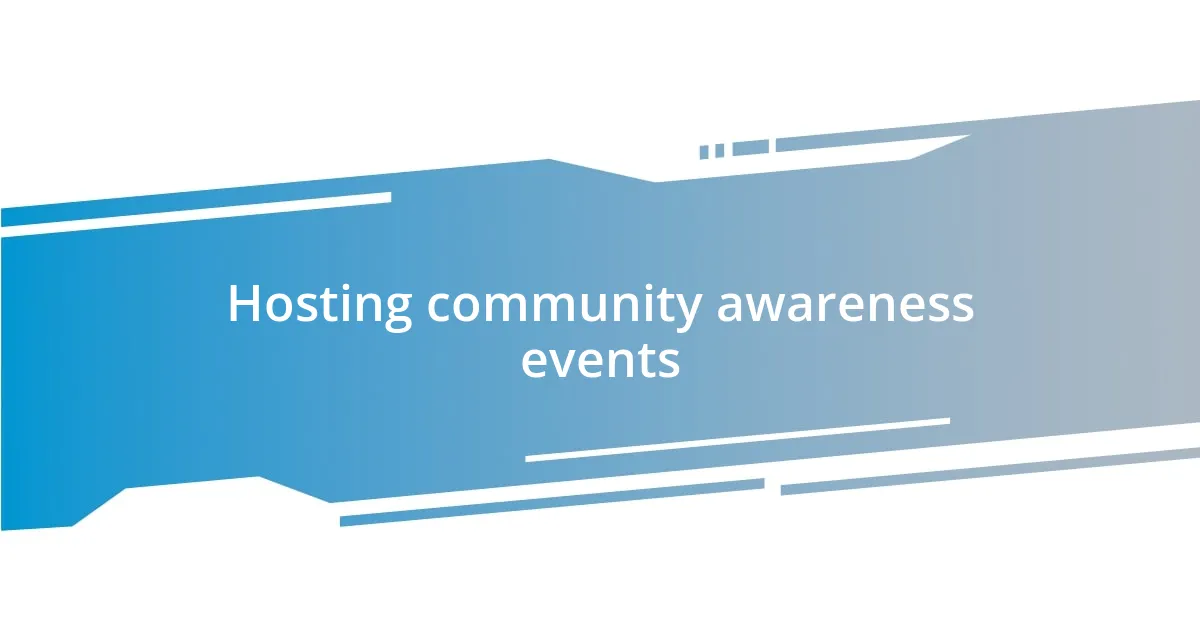
Sharing personal experiences and stories
Sharing personal experiences and stories can deeply resonate with others, especially when it comes to epilepsy. I recall a time at a community event when I met a young woman who shared her journey. As she spoke about her first seizure and the fear that followed, I felt a knot in my stomach because it mirrored my own experience. It was a poignant reminder of how vital it is for us to share our stories—revealing our vulnerabilities can foster a profound sense of connection. Have you ever had a moment like that, where someone’s story helped you feel less alone?
Another instance that stands out to me was during a local support group meeting. I decided to open up about my struggles with stigma and misunderstanding surrounding epilepsy. It was liberating; I watched as others nodded in agreement, and even shared their reflections. By sharing our stories, we created a safe space that facilitated open dialogue. This shared vulnerability often sparks healing discussions—don’t you think it’s powerful how our stories can unite us?
The power of storytelling also became evident during a school presentation I gave. After I shared my journey, a student approached me, eyes wide with understanding. She revealed that her brother had epilepsy, and she never truly grasped what he experienced until now. That moment filled me with warmth; knowing that my honesty helped her empathize with her brother brought the importance of sharing stories into sharp focus. Have you noticed how one shared experience can light the way for someone else? It reminds me why I am passionate about educating others through the lens of our personal narratives.
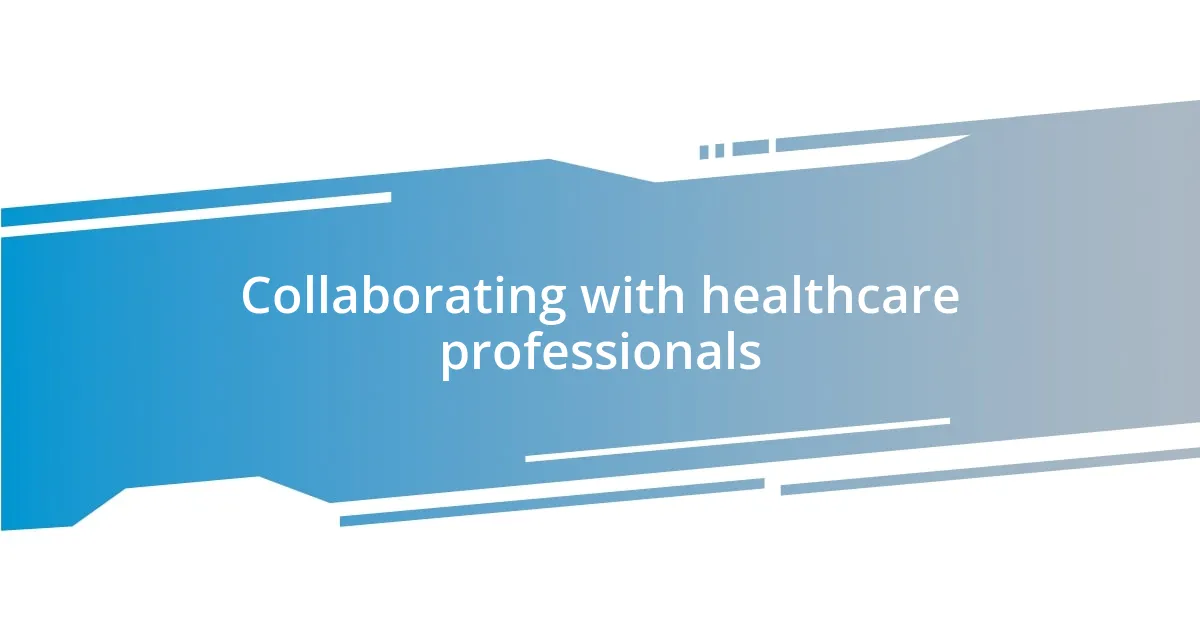
Collaborating with healthcare professionals
Collaborating with healthcare professionals is crucial in my journey to educate others about epilepsy. I remember the first time I attended a health fair with local doctors and specialists who were passionate about raising awareness. As we spoke, I realized how valuable their expertise was—like when a neurologist explained the science behind seizures. That knowledge gave me the confidence to share accurate information with my community. Isn’t it interesting how professionals can provide insights that help shape our understanding?
Building a network with healthcare providers also deepened my understanding of patient needs. During a discussion, a nurse shared a poignant story of a patient who struggled with medication adherence due to side effects. I was moved by her empathy and realized that education isn’t just about sharing facts; it’s about addressing real issues that affect individuals daily. Have you ever considered how these conversations can inform our approach to educating others?
I’ve found that collaborating with healthcare professionals not only enhances credibility but fosters trust within the community. For example, I once co-hosted a workshop with a doctor who specialized in epilepsy. We addressed questions like, “What should someone do during a seizure?” This joint approach made the event more impactful, allowing us to provide a balanced view of medical information and personal experiences. Isn’t it amazing how these partnerships can amplify our message and ensure it reaches those who need it most?
